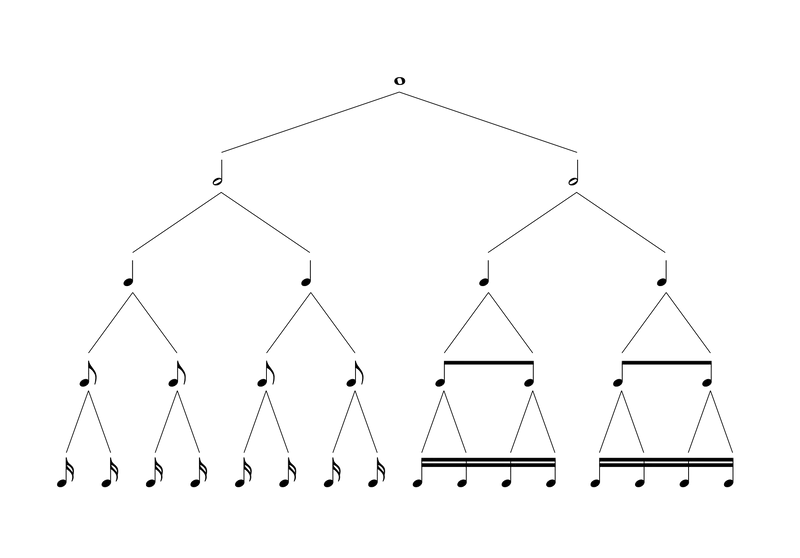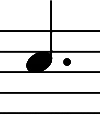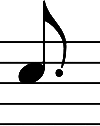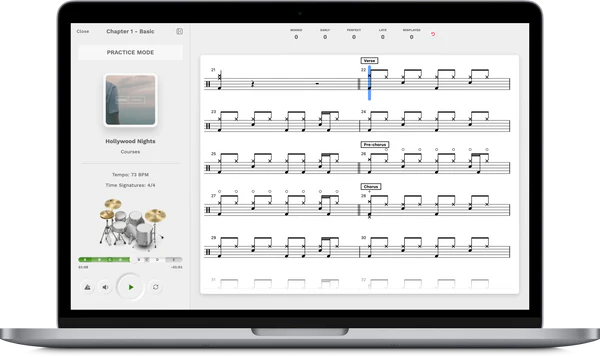How to Read Drum Sheet Music: A Beginner’s Guide

Learning to read drum sheet music can seem intimidating, but once you understand the basics, it becomes a powerful tool to enhance your drumming skills. In this guide, we’ll take you through the essentials, starting from the fundamentals of drum notation, and by the end, you'll be ready to follow along with drum sheets in our Freedrum Studio courses.
Understanding the Staff and Clefs
Drum notation uses five parallel lines called a staff just like other melodic instruments. The placement of the drums and cymbals on this staff is similar to a map, where each drum or cymbal has its own place on the lines. Sometimes they are placed directly on the lines and other times they are placed between the lines.
A standard drum set placement, also known as a drum key, can be seen in the image below. The drums are represented with round notes, while the cymbals are represented with crosses.

In drum notation, we use a special symbol called the drum clef, which helps identify that this staff is for drums, not melodic instruments like guitar or piano.
| Drum Clef | Treble Clef | Bass Clef |
 |
 |
 |
Time Signatures and Tempo
When you look at drum sheet music, you’ll often see two numbers stacked at the beginning of the staff. This is the time signature, which shows how many beats are in each bar.
A beat is the basic unit of time in music, similar to the rhythm you feel when dancing, clapping, or tapping your foot along with a song.
Music is divided into bars (or measures) by vertical lines called bar lines. Each bar contains a set number of beats, determined by the time signature. The top number tells you how many beats are in each bar, while the bottom number indicates the type of note that counts as one beat.
For example, the time signature 4/4 means there are 4 beats in each bar, and each beat is equal to a quarter note. This is the most common time signature and is often shown as a big C for common time.

Another example is 12/8, where there are 12 beats per bar, and each beat is worth an eighth note.

Here are some examples of different time signatures and how they sound:
| 4/4 | 2/4 | 3/4 | 6/4 | 3/8 | 6/8 | 12/8 |
|
|
|
|
|
|
|
|
Tempo refers to the speed of the music, measured in beats per minute BPM. A higher BPM means a faster tempo.
For example, if a song has a tempo of 60 BPM in 4/4 time, that means there are 60 beats in one minute and each of the four quarter notes in each bar will happen once per second. The tempo affects how the music feels and can change the overall mood or energy of the song.

Note Values: How Long to Play
Notes tell you how long to play a sound, and rests indicate silence for the same durations. The main note values include:
Whole notes have the longest duration of all notes. In 4/4 time, the whole note and whole note rest lasts four beats.


Half notes have half the duration of whole notes, which means it takes two half notes to equal the duration of one whole note. In 4/4 time, the half note and half note rest lasts two beats.


The quarter note is a note that lasts for one beat in 4/4 time. It is named after its duration, as it represents one quarter of a whole note.


An eighth note lasts for half a beat. To make it easier to read, two or more eighth notes can be connected by a horizontal line called a beam.



The sixteenth note and sixteenth note rest lasts for one-fourth of a beat. Multiple sixteenth notes can be connected by using two beams.



To help you understand note values, you can use a note tree. This is a diagram that shows how notes are divided into smaller parts. For example, a whole note is worth four beats, while a half note is worth two beats. A quarter note is worth one beat, and so on.

Triplets: Dividing a Note into Three Equal Parts
Triplets divide a note into three equal parts instead of the usual two. They create a distinct, flowing feel often associated with styles like jazz, blues, and shuffle grooves.
For example, in 4/4 time:
A quarter note triplet divides a half note into three equal parts. So, instead of two eighth notes fitting into one beat, you’ll have three notes that each take up one-third of a beat.

An eighth note triplet divides a single quarter note into three equal eighth notes.

A sixteenth note triplet divides a single quarter note into six equal sixteenth notes.

Triplets often give music a more swinging or rolling feel because they disrupt the usual rhythm patterns of two or four subdivisions.
Dotted Notes: Adding More Length to Notes
A dotted note is simply a note with a small dot placed directly after it. The purpose of the dot is to increase the note’s duration by half of its original value. This slight extension can make rhythms feel more fluid and syncopated.
For example:
A dotted quarter note is worth one and a half beats in 4/4 time. Normally, a quarter note lasts for one beat, but the dot adds half of that value (which is ½), giving you a total of 1 + ½ = 1.5 beats.




Dynamics: Playing with Expression
Dynamic markings are symbols used to indicate how quiet or loud you should play. Here are some of the most common dynamic markings:
- ppp (pianississimo or triple-piano) – very, very quiet
- pp (pianissimo or double-piano) – very quiet
- p (piano) – quiet
- mp (mezzo-piano) – moderately quiet
- mf (mezzo-forte) – moderately loud
- f (forte) – loud
- ff (fortissimo or double-forte) – very loud
- fff (fortississimo or triple-forte) – very, very loud
These symbols help you to express the dynamics of a piece of music and create a more expressive and emotional performance.
A crescendo is a symbol used in music to indicate a gradual increase in volume. It means that the music should start off quiet and then gradually get louder. Make sure to pay attention to how long the symbol lasts and slowly increase the volume over that time period.

A decrescendo or diminuendo is a symbol that indicates a gradual decrease in volume. It's important to pay attention to how long the symbol lasts and gradually reduce the volume over that period of time.

Another key aspect of drumming dynamics is the use of ghost notes, which are played softly, and accents, which are louder notes that stand out in a groove.
Ghost notes are soft and subtle notes that are played in grooves, often on the snare drum, to add texture and complexity. They are commonly used in groove-based genres like funk, hip-hop, blues, and drum 'n' bass, but can be applied to any style of music. In order to use them effectively, it's important to have good dynamic control so that you can create contrast between your louder notes and the quieter ghost notes. When notating ghost notes, they are usually placed in brackets to differentiate them from the louder notes in the groove.

Accented notes are played with more emphasis and are louder than the surrounding notes. This is usually indicated by a wedge-shaped symbol pointing to the right, placed above or below the note depending on whether it is played with the hands or feet.

Common Drum Notation Symbols
Drum notation uses specific symbols to represent different techniques:
Hi-hat: If you see a small 'o' symbol above a hi-hat note, it means you should play the hi-hat open, which creates a more sustained and longer sound. You can do this by lifting the front or the whole foot to open the hi-hat. On the other hand, if you see a '+' symbol, it means you should play the hi-hat closed by lowering your foot to create a shorter sound. These symbols are commonly used in drum notation to indicate how to play the hi-hat in a particular rhythm or pattern.

Flams: When you see a small note connected to a normal note, it's called a flam. The small note is played just a little bit before the normal note. It's important to remember that the small note doesn't have a value, so you don't count it when figuring out how long each note lasts in a bar.


These symbols are essential for understanding drum-specific patterns, whether you’re playing grooves, fills, or rudiments.
Putting it All Together: Playing with Sheet Music
Once you’ve grasped the basics, you can start playing along with simple drum sheet music. Practice is key. Reading sheet music, like drumming, is a skill that improves with repetition. As you practice, you’ll begin to recognize common rhythmic patterns, and over time, they’ll become second nature.
By consistently practicing with drum sheets, you’ll internalize rhythms, note placement, and musicality. Soon, you’ll be reading effortlessly along with the Freedrum Studio courses! The more you read, the easier it becomes, unlocking faster learning and more opportunities as a drummer. If you haven’t started reading drum sheet music yet, now’s the perfect time to start.

If you're interested in trying Freedrum Studio, there's a special promotion available. Use the code: DRUMSFORLIFE at checkout to get 30 days of access for just $1. It's a great opportunity to explore the platform's unique features and see how it can help you improve your drumming skills.



